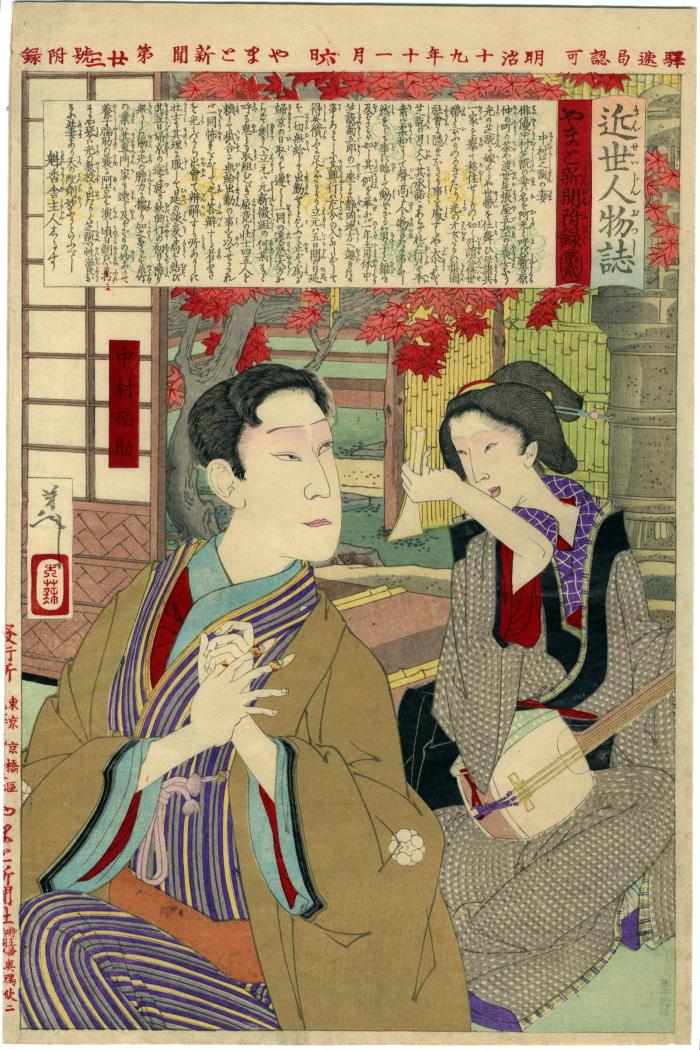Tsukioka Yoshitoshi (月岡芳年) (artist 04/30/1839 – 06/09/1892)
Nakamura Shikan's wife (中村福助の妻) from the series The Stories About the People In The Recent Times (Kinsei Jinbutsu Shi - 近世人物誌)
11/1886
9.375 in x 14.125 in (Overall dimensions) Japanese woodblock print
Signed: Yoshitoshi (芳年)
Publisher: Yamato Shinbunsha (やまと新聞)
Date: Meiji 19, 11th month, 6th day
明治十九年十一月六日
Carver: 彫工國活
Waseda University
Tokyo Metropolitan Library
Ritsumeikan University
Lyon Collection - another print from this series: the wrestler Tanafuji Tarō
Lyon Collection - another print from this series: Muraoka
Lyon Collection - another print from this series: wife of the last shōgun
Lyon Collection - another print from this series: the wife of Kawase Omitsu, the wife of kabuki actor Nakamura Shikan and her adopted son Fukusuke. Insert No. 2 for Yamato Newspaper. There are at least 20 prints in this series of which the Lyon Collection owns five.
****
The text reads:
中村(なかむら)芝翫(しくわん)の妻(つま)/ 俳優(はいゆう)中村(なかむら)芝翫(しくわん)の妻(つま)ハ名(な)を阿光(おミつ)と呼(よ)び新吉原(しんよしハら)/ 仲(なか)の町(ちよう)の茶(ちや)や渡世(とせい)尾張屋(おはりや)五兵エ(ごへゑ)の養女(やうぢよ)なり / 光(ミつ)の芝翫(しくわん)に嫁(か)するや世帯(せたい)を仕舞(しま)ひ母諸共(ははもろとも)/ 一家(いつか)を挙(あげ)て移住(ゐぢう)せしものの如(ごと)く所謂(いはゆる)合併(がつへい)世(せ)/ 帯(たい)と云(い)ふものめきたり光(ミつ)の才女(さひぢよ)たるハ梨園(りえん) 社会(しやくわい)に隠(かく)れなきも事(こと)を処(しよ)するや大小(だいせう)となく芝翫(しわん)の耳(ミミ)に入(いれ)て其(その)承諾(しようたく)にあらざれバ行(おこな)ハず平(へい)/ 素(そ)ハ柔和(にうわ)にして声高(こハだか)に人(ひと)と物言(ものいひ)たる事(こと)なし / 然(しか)れども事(こと)に臨(のぞ)ミて動(どう)ぜざるハ男子(なんし)と雖(いへど)も / 及(およ)ばざるが如(ごと)し其(その)一例(いちれい)を挙(あげ)なバ一年(ひととせ)土用(どよう) 休中(やすミちう)/ 芝翫(しくわん) 菊五郎(きくごらう)の一座(いちざ)にて静岡(しづおか)地方(ちはう)へ趣(おもむ)きたる / 事(こと)ありしに其(その)興行(かうぎよう)ハ充分(じうぶん)の入(いり)ならざりて / 得失(とくしつ)償(つぐな)ふに足(た)らざるより立元(たてもと)ハ五日間(いつかかん)の日延(ひのべ)/ を一切(いつさい)無給(むきう)にて出勤(しゆつきん)せよと乞(こ)ふて止(やま)ず為(ため)に / 帰京(ききよう)の日取(ひど)りを遅(おそ)くし一同(いちどう)の迷惑(めいはく)大方(おほかた)ならず剰(あまつ)さへ立元(たてもと)ハ元新徴組(もとしんちようぐミ)の何某(なにがし)など呼(よべ)る鬼(おに)とも取組(とりく)むべき屈竟(くつきよう)の壮士(さうし)四五人を頼(たの)ミて掛合(かけあふ)に無給(むきう) 出勤(しゆつきん)の事(こと)を以(もつ)てせかされバ一同(いちどう)怖(おそ)れをなして之(これ)に答弁(たふべん)する者(もの)なきを光(ミつ)ミづから出会(いであふ)て弁解(べんかい)する所(ところ)ありしに壮士(さうし)も其理(そのり)に服(ふく)して日延(ひのべ)の談(だん)爰(ここ)に局(きよく)を結(むす)び / 其(その)翌日(よくじつ)帰京(ききやう)の途(ミち)に就(つ)き秋(あき)興行(かうきやう)の初日(しよにち)に障(さハ)り / 無(なか)りしハ偏(ひとへ)に光(ミつ)の胆力(たんりよく)を拠(よれ)り加之(しかのミ)ならず糸竹(いとたけ)/ の業(わざ)ハ其(その)専門家(せんもんか)も遠(とほ)く及(およ)ばざるの妙(めう)ありて / 養子(やうし)福助(ふくすけ)の曩(さき)に阿古(あこ)やを演(えん)じ頃日(このころ)朝皃(あさかほ)に扮(ふん)/ するや琴(こと)ハ光(ミつ)の教授(けうじゆ)に出(いで)たりと芝翫(しくわん)の性(せい)温良(おんりやう)な / るに此(この)妻(つま)あり天(てん)の配剤(はいさい)妙(めう)なりというべし / 魁香舎(くわいかうしや)主人(しゆじん)しるす
****
There had been a prohibition against portraying contemporary events prior to the Meiji Restorations. However, in the 1870s newspapers began to appear with some degree of impunity. Sarah E. Thompson noted in Undercurrents in the Floating World: Censorship and Japanese Prints on page 88 that a special kind of nishiki-e known as 'newspaper prints' also began to appear. "Although these prints derived their content from the newspapers, they were printed and sold separately. They may sometimes have been used as color supplements for the "small" newspapers aimed at a popular audience. A typical "newspaper print" included a logo with the name of the newspaper, a text derived from a recent article, and an artist's imaginary rendition of the scene. The articles selected for illustration were often tales of exemplary moral behavior, but they also included lurid crime scenes and even ghost stories related as factual events."
****
There is another copy at the University of Tokyo Modern Japanese Hosei Historical Materials.
****
Shinichi Segi wrote on page 154 in Yoshitoshi: The Splendid Decadent: "Also portrays Danjūrō in the Personalities of Recent Times series, which the actor much admires. Completes twentieth and final portrait of Personalities of Recent Times series; adds full-color print cover, and has the set bound in book form."
On page 132 Segi wrote: "Over the two-year period from 1887 to 1888, Yoshitoshi produced his last and most accomplished set of "newspaper prints" as irregular supplements to the Yamato Shimbun. The full set of twenty prints... was later bound in one volume, with the additions of a title plate... The series as a whole shows Yoshitoshi's mature style of figuration based on careful drawing from models. The line work is masterful, and the exactingly balanced choice of colors employs the bright, imported aniline dyes sparingly, as points of compositional accent. The subjects were people in the news, and persons who helped shape modern Japan."
Yamato Shinbunsha (大和新聞社) (publisher)
Meiji era (明治時代: 1868-1912) (genre)
Historical - Social - Ephemera (genre)
Nakamura Fukusuke III (三代目中村福助: from 03/1868 to 09/1907) (actor)
